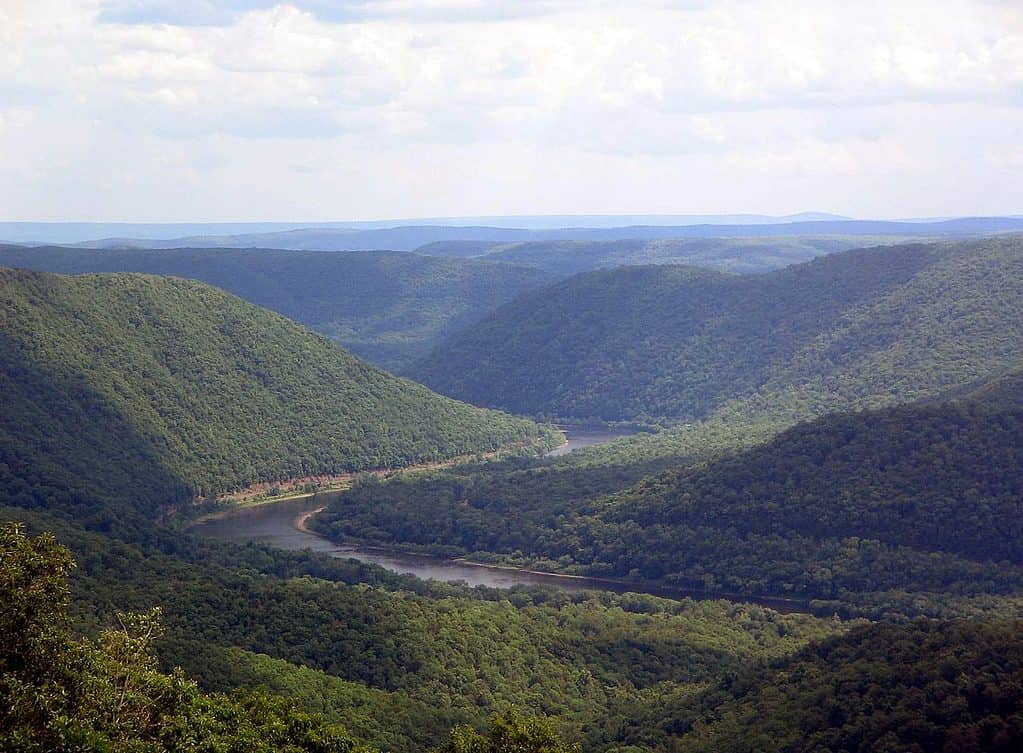The Susquehanna is an important and significant river on the East Coast of the United States. It flows from Upstate New York to Maryland’s Chesapeake Bay for over 400 miles and is regarded as one of the largest rivers in the United States. But apart from its length, the Susquehanna River is one of the oldest in the world, dating back at least 320 million years. In fact, it’s older than the mountains it flows through. This river has been a source of life for humans and animals for centuries and continues to this day. And people also use its waters for recreational enjoyment, such as boating and fishing. Discover all there is to know about the Susquehanna River, including its location, history, size, depth, activities, and more.
Susquehanna River Location

The main branch of the Susquehanna, also known as the North Branch, rises out of Otsego Lake in Cooperstown, New York. It runs west through farm country, adding on the Unadilla River before turning a sharp 90 degrees west at Susquehanna, Pennsylvania. Then another 90 degrees north at Great Bend. It flows again briefly into New York before returning to Pennsylvania and cutting through the Endless Mountains and receiving the West Branch at Northumberland. The West Branch originates near Elmora, Pennsylvania. The drainage basin includes the Allegheny Plateau in the Appalachians. It makes a zigzag course through Maryland before emptying into the Chesapeake Bay.
Susquehanna River Size and Depth

The Susquehanna River’s main branch originates in Cooperstown, New York
©Ruhrfisch / CC BY-SA 3.0, via Wikimedia Commons – License
The Susquehanna River is 444 miles long and is the longest river on the East Coast. It is also one of the largest in the United States in terms of watershed area. It drains almost half of Pennsylvania’s land area, with a total of 27,500 square miles. And it provides half of the Chesapeake Bay’s freshwater inflow. This river is broad and shallow, making it easy to navigate. It has a max depth of 39 feet, with an average depth between five and ten feet.
Susquehanna River History

The French explored the area around the Susquehanna in 1615
©Jayce Wyatt Photography/Shutterstock.com
The land adjacent to the river was once inhabited by the Susquehannock people before the French explored it in 1615. After the Iroquois conquested the Susquehannock, the Lenape moved into the area. And in the 18th century, the Pennsylvania colony founder William Penn, negotiated with the Lenape to allow settlers to live near the Susquehanna and Delaware Rivers. The river has been used for transportation, such as shipping coal and Revolutionary War expeditions. And industrial centers began popping up along the banks during the 19th century. The Susquehanna has also been the site of several major hurricanes that have caused devastating flooding.
Susquehanna River Formation
The Susquehanna is steeped in rich history thanks to its age. It is one of the oldest rivers on earth, predating the formation of the Appalachian Mountains. The river is estimated around 320 to 340 million years old and would have been around when dinosaurs roamed the earth. Susquehanna would have formed during the Carboniferous Period when the world was covered in thick swampland.
Susquehanna River Wildlife

View of the Safe Harbor Dam on the Susquehanna River, Pennsylvania, as seen from the Enola Low-Grade Trail.
©U.S. Environmental Protection Agency / Public domain – License
As it flows through lush mountains and valleys, the Susquehanna supports wildlife of all kinds. From fish within its waters to large mammals on its banks. Living along the river floor is yellow lampmussels, river mussels, and eastern oysters. Near its water are damselflies, dragonflies, and butterflies. You can also find newts, green frogs, salamanders, and American toads.
For reptiles, you might see wood turtles, eastern copperheads, and snapping turtles. And the abundant fish include lamprey, sturgeon, bass, gar, bowfin, and eel. You might find wild turkeys and pheasants nearby. Or nighthawks, swifts, ducks, cuckoos, and hummingbirds perched on a branch or flying over the water. And some of the mammals include opossums, pikas, eastern cottontails, beavers, porcupines, voles, muskrats, shrews, bats, cougars, bobcats, wolves, foxes, coyotes, moose, elk, and deer.
Susquehanna River Fishing
The Susquehanna River is known for its popular fishing spots, where you can catch largemouth bass, smallmouth bass, walleye, panfish, rainbow trout, perch, bullheads, and catfish. Several state parks along the river offer excellent fishing spots, such as the Milton State Park and the Shikellamy State Park. And Penns Creek is one of the most popular spots along the river. The tributary is 66 miles long and offers some of the best wild trout fishing in the Eastern United States. Susquehanna River is also a premier bass fishing river in the country.
Susquehanna River Activities
Along with fishing, you will also find many more recreational opportunities along the river’s 400 miles.
- Boating
- Kayaking
- Canoeing
- Hiking
- Biking
- Camping
- Water skiing
- Swimming (only in some areas)
The photo featured at the top of this post is © Jayce Wyatt Photography/Shutterstock.com
Thank you for reading! Have some feedback for us? Contact the AZ Animals editorial team.






